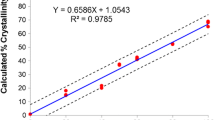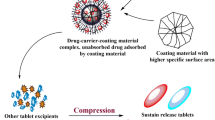ABSTRACT
Purpose
Use isothermal microcalorimetry to directly evaluate the effects of excipients and water content to produce a stable amorphous glycopyrrolate pressurized metered dose inhaler (pMDI) formulation.
Methods
Amorphous glycopyrrolate particles with and without excipients (Distearoyl-sn-glycero-3-phosphatidylcholine (DSPC) or β-cyclodextrin (βCD)) were spray dried and cold filled along with HFA 134a into customized thermal activity monitor (TAM) measurement ampoules. When applicable, a known amount of water was also pipetted into the ampoule. Sample ampoules were hermetically sealed, equilibrated to 25°C and measured isothermally for at least 24 h using the TAM III (TA Instruments, Sollentuna, Sweden).
Results
Amorphous glycopyrrolate particles were highly unstable and crystallized rapidly when suspended in HFA 134a. Co-spray drying the glycopyrrolate with DSPC failed to mitigate this instability, but co-spray drying with βCD protected the amorphous glycopyrrolate from crystallization, resulting in a stable formulation at low water contents (≤100 ppm).
Conclusions
This study shows that isothermal microcalorimetry can easily differentiate between physically stable and unstable pMDI formulations of glycopyrrolate within a few hours. Furthermore, it allows rapid screening of various formulation factors (drug form, excipients, water ingress), which can greatly reduce the time required to develop marketable products with acceptable shelf life.












Similar content being viewed by others
Abbreviations
- (CaCl2):
-
Calcium chloride
- (COPD):
-
Chronic obstructive pulmonary disease
- (DSPC):
-
Distearoyl-sn-glycero-3-phosphatidylcholine
- (FTIR):
-
Fourier transform infrared
- (GP):
-
Glycopyrrolate
- (pMDIs):
-
Pressurized metered dose inhalers
- (TAM III):
-
Thermal activity monitor III
- (Tg):
-
Glass transition temperature
- (βCD):
-
β-Cyclodextrin
REFERENCES
Cazzola M, Matera M. Emerging inhaled bronchodilators: an update. Eur Respir J. 2009;34(3):757–69.
Hansel TT, Neighbour H, Erin EM, Tan AJ, Tennant RC, Maus JG, et al. Glycopyrrolate causes prolonged bronchoprotection and bronchodilatation in patients with asthma. CHEST J. 2005;128(4):1974–9.
Verkindre C, Fukuchi Y, Flémale A, Takeda A, Overend T, Prasad N, et al. Sustained 24-h efficacy of NVA237, a once-daily long-acting muscarinic antagonist, in COPD patients. Respir Med. 2010;104(10):1482–9.
Hancock BC, Carlson GT, Ladipo DD, Langdon BA, Mullarney MP. Comparison of the mechanical properties of the crystalline and amorphous forms of a drug substance. Int J Pharm. 2002;241(1):73–85.
Hancock BC, Parks M. What is the true solubility advantage for amorphous pharmaceuticals? Pharm Res. 2000;17(4):397–404.
Hancock BC, Zografi G. Characteristics and significance of the amorphous state in pharmaceutical systems. J Pharm Sci. 1997;86(1):1–12.
Craig DQ, Royall PG, Kett VL, Hopton ML. The relevance of the amorphous state to pharmaceutical dosage forms: glassy drugs and freeze dried systems. Int J Pharm. 1999;179(2):179–207.
Morton D, Shott M, Davies R. Methods for preparing dry powder compositions of glycopyrrolate. In: EP Pat. 2012;1:755,555.
Dellamary LA, Tarara TE, Smith DJ, Woelk CH, Adractas A, Costello ML, et al. Hollow porous particles in metered dose inhalers. Pharm Res. 2000;17(2):168–74.
Tarara TE, Hartman MS, Gill H, Kennedy AA, Weers JG. Characterization of suspension-based metered dose inhaler formulations composed of spray-dried budesonide microcrystals dispersed in HFA-134a. Pharm Res. 2004;21(9):1607–14.
Lechuga-Ballesteros D, Vehring R, Noga B, Cummings H, Dwivedi SK. The future of COPD combination therapy: universal approach to enable equivalent delivery of single, double and triple combinations. Futur Med Chem. 2011;3:1703–18.
Lechuga-Ballesteros D, Vehring R, Dwivedi SK. A New Cosuspension MDI Platform: Scientific Foundations of Mono, Dual and Triple Combination Products. In: Dalby PR Byron RN, Peart J, Suman JD, Young PM, editors. Respiratory Drug Delivery. Berlin: Davis Healthcare International Publishing; 2011. p. 101–11.
Vehring R, Lechuga-Ballesteros D, Joshi V, Noga B, Dwivedi SK. Cosuspensions of microcrystals and engineered microparticles for uniform and efficient delivery of respiratory therapeutics from pressurized metered dose inhalers. Langmuir. 2012;28(42):15015–23.
D’Sa D, Williams L, Speck J, Dwivedi S, Lechuga-Ballesteros D. Thermodynamic and Structural effects of CaCl2 on the Phase Transitions and Structures of Distearoyl-Phosphatidylcholine (DSPC) by Differential Scanning Calorimetry and X-Ray Diffraction. Washington: In.AAPS Annual Meeting and Exposition; 2011.
Stella VJ, Rajewski RA. Cyclodextrins: their future in drug formulation and delivery. Pharm Res. 1997;14(5):556–67.
Lechuga-Ballesteros D, Noga B, Vehring R, Cummings RH, Dwivedi SK. Novel cosuspension metered-dose inhalers for the combination therapy of chronic obstructive pulmonary disease and asthma. Futur Med Chem. 2011;3(13):1703–18.
Miller NC. The Effects of Water in Inhalation Suspension Aerosol Formulations. Boca Raton: CRC Press; 1990.
Williams III RO, Hu C. Moisture uptake and its influence on pressurized metered-dose inhalers. Pharm Dev Technol. 2000;5(2):153–62.
Lechuga-Ballesteros D, Bakri A, Miller DP. Microcalorimetric measurement of the interactions between water vapor and amorphous pharmaceutical solids. Pharm Res. 2003;20(2):308–18.
Miller DP, Lechuga-Ballesteros D. Rapid assessment of the structural relaxation behavior of amorphous pharmaceutical solids: effect of residual water on molecular mobility. Pharm Res. 2006;23(10):2291–305.
D’Sa D, Lechuga-Ballesteros D, Chan H-K. Isothermal Microcalorimetry of pressurized systems I: A Rapid Method to Evaluate Pressurized Metered Dose Inhaler Formulations Pharmaceutical Research. Accepted.
Thermal Activity Monitor III Manaul In: TA Instruments, editor.; 2012.
Srikanth M, Babu G, Rao N, Sunil S, Balaji S, Ramanamurthy K. Dissolution rate enhancement of poorly soluble bicalutamide using β-cyclodextrin inclusion complexation. Int J Pharm Pharm Sci. 2010;2(1):191–8.
Hirayama F, Usami M, Kimura K, Uekama K. Crystallization and polymorphic transition behavior of chloramphenicol palmitate in 2-hydroxypropyl-β-cyclodextrin matrix. Eur J Pharm Sci. 1997;5(1):23–30.
Uekama K, Hirayama F, Irie T. Cyclodextrin drug carrier systems. Chem Rev. 1998;98(5):2045–76.
Hirayama F, Uekama K. Methods of investigating and preparing inclusion compounds. Cyclodextrins and their industrial uses. Paris: Editions de Santé; 1987. p. 131–72.
Esclusa-Diaz M, Torres-Labandeira J, Kata M, Vila-Jato J. Inclusion complexation of glibenclamide with 2-hydroxypropyl-β-cyclodextrin in solution and in solid state. Eur J Pharm Sci. 1994;1(6):291–6.
Shan-Yang L, Yuh-Horng K. Solid particulates of drug-β-cyclodextrin inclusion complexes directly prepared by a spray-drying technique. Int J Pharm. 1989;56(3):249–59.
Hassan MA, Suleiman MS, Najib NM. Improvement of the in vitro dissolution characteristics of famotidine by inclusion in β-cyclodextrin. Int J Pharm. 1990;58(1):19–24.
Loftsson T, Brewster ME. Pharmaceutical applications of cyclodextrins. 1. Drug solubilization and stabilization. J Pharm Sci. 1996;85(10):1017–25.
Del Valle EM. Cyclodextrins and their uses: a review. Process Biochem. 2004;39(9):1033–46.
Bergeron R. Cycloamylose-substrate binding. Inclusion Compounds. 3rd ed. London: Academic; 1984. p. 391–443.
Reynolds JM, McNamara DP. Model for moisture transport into inhalation aerosols. Pharm Res. 1996;13(5):809–11.
Loftsson T, Vogensen SB, Brewster ME, Konráðsdóttir F. Effects of cyclodextrins on drug delivery through biological membranes. J Pharm Sci. 2007;96(10):2532–46.
Brewster ME, Vandecruys R, Peeters J, Neeskens P, Verreck G, Loftsson T. Comparative interaction of 2-hydroxypropyl-β-cyclodextrin and sulfobutylether-β-cyclodextrin with itraconazole: phase-solubility behavior and stabilization of supersaturated drug solutions. Eur J Pharm Sci. 2008;34(2):94–103.
ACKNOWLEDGEMENTS AND DISCLOSURES
The authors gratefully acknowledge [1] the financial support of the Australian Research Council (DP120102778) and [2] the facilities, and the scientific and technical assistance of the Australian Centre for Microscopy and Microanalysis at the University of Sydney. D. D’Sa is a recipient of the Australian IPRS and APA scholarships.
Author information
Authors and Affiliations
Corresponding author
Rights and permissions
About this article
Cite this article
D’Sa, D.J., Lechuga-Ballesteros, D. & Chan, HK. Isothermal Microcalorimetry of Pressurized Systems II: Effect of Excipient and Water Ingress on Formulation Stability of Amorphous Glycopyrrolate. Pharm Res 32, 714–722 (2015). https://doi.org/10.1007/s11095-014-1499-8
Received:
Accepted:
Published:
Issue Date:
DOI: https://doi.org/10.1007/s11095-014-1499-8




